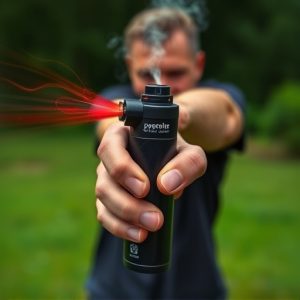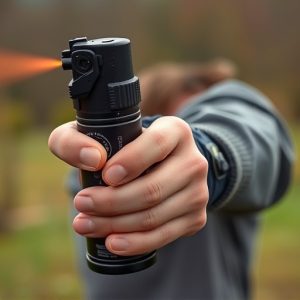Pepper Spray for Crowd Control: Legal, Effective, and Concealable Techniques
Concealed pepper spray carrying techniques are a vital skill for law enforcement, enabling safe and…….
Concealed pepper spray carrying techniques are a vital skill for law enforcement, enabling safe and effective crowd control in high-pressure situations. Officers learn swift deployment methods while maintaining their safety, breaking up tense crowds without causing harm or escalation. This involves understanding pepper spray mechanics, legal regulations, and specific drawing techniques. Responsible use is crucial in the digital age to maintain public trust, with training emphasizing de-escalation and communication skills. These techniques ensure discretion and quick access during emergencies, balancing public safety with individual rights.
“In modern crowd control tactics, concealed pepper spray carrying techniques have emerged as a vital tool for law enforcement. This comprehensive guide explores the multifaceted aspect of pepper spray as a crowd control measure. From understanding its chemical composition and effectiveness to delving into legal frameworks, we provide insights on optimal concealed carrying methods for officers.
We discuss training programs, safety protocols, real-world applications, and more, offering a detailed exploration of this game-changer in public safety, especially in the context of concealed pepper spray carrying techniques.”
- Understanding Pepper Spray as a Crowd Control Tool
- – Definition and chemical composition of pepper spray
- – Effectiveness in crowd control scenarios
- – Legal considerations and regulations surrounding its use
Understanding Pepper Spray as a Crowd Control Tool
Pepper spray, a powerful crowd control agent, has become an integral part of law enforcement arsenal for managing and dispersing large gatherings. As a non-lethal option, it offers a safe yet effective way to incapacitate individuals without causing permanent harm. When deployed correctly, pepper spray can quickly break up tense situations and ensure the safety of both officers and bystanders.
Understanding the concealed carrying techniques of pepper spray is crucial for law enforcement officers. This involves mastering various methods to deploy the spray efficiently while maintaining their own safety. Training programs often include practice scenarios that simulate real-world crowd control situations, equipping officers with the skills to make swift decisions in high-pressure environments. Concealed pepper spray carrying techniques focus on discreteness and rapid response, allowing officers to remain unseen until the spray is needed, thus minimizing potential provocation or escalation.
– Definition and chemical composition of pepper spray
Pepper spray, also known as oleoresin capsicum (OC) spray, is a non-lethal crowd control agent composed primarily of capsaicin, a chemical derived from chili peppers. This irritant targets the eyes and respiratory system, causing temporary blindness and difficulty breathing, thereby enabling law enforcement to subdue and disperse crowds quickly. The chemical compound is typically suspended in a water-based solution with a surfactant to enhance its stickiness, allowing it to cling to skin and clothing for prolonged effects.
Carrying concealed pepper spray involves learning effective techniques to ensure its safe and legal deployment. Users must understand the spray’s range, activation mechanisms, and de-activation procedures. Proper training in concealed carrying encompasses mastering different holsters and pouches designed for discreteness, as well as practicing drawing and aiming techniques under various scenarios. Understanding local laws regarding pepper spray possession and use is paramount to avoid legal repercussions while engaging in crowd control situations.
– Effectiveness in crowd control scenarios
Pepper spray, when used properly, can be an effective crowd control tool. Its rapid onset of effects disorient and disable individuals, temporarily halting any aggressive behavior or mass movement. In crowded spaces, where direct physical intervention might prove challenging or dangerous, pepper spray offers a safer alternative for law enforcement to maintain order. The strategic deployment of officers equipped with concealed pepper spray can be particularly useful in situations like large public gatherings, protests, or even emergency evacuations, ensuring the swift and orderly dispersal of crowds.
Mastering concealed pepper spray carrying techniques is key to its effectiveness in crowd control scenarios. Officers must be trained in discreet application methods that minimize exposure while maximizing impact. This includes learning to accurately assess crowd dynamics, identify potential ringleaders, and quickly deploy the spray without causing panic or injury to bystanders. In today’s digital era, where video footage can quickly spread, responsible use of pepper spray is crucial not just for crowd control but also for maintaining public trust.
– Legal considerations and regulations surrounding its use
The legal landscape surrounding pepper spray as a crowd control measure is complex and varies significantly across jurisdictions. In many regions, its use by law enforcement is strictly regulated to ensure accountability and prevent misuse. Authorities typically dictate specific circumstances under which pepper spray can be employed, focusing on scenarios where it’s necessary for self-defense or to restore order in situations of civil unrest. The rules also outline the training requirements for officers, detailing the concealed pepper spray carrying techniques they must master to deploy the substance safely and effectively.
Regulations often mandate that officers receive comprehensive instruction in de-escalation tactics before resorting to pepper spray. This includes learning how to identify potential threats, communicate with agitated individuals, and only use force as a last resort. Additionally, there are rules about when and where officers can carry concealed pepper spray, emphasizing the need for discretion and proportionality. Concealed pepper spray carrying techniques focus on minimizing its visibility while ensuring quick access in emergency situations. These regulations aim to balance public safety with individual rights, promoting responsible law enforcement practices.
Pepper spray, a powerful crowd control tool, has proven effective in various scenarios due to its quick-acting chemical composition. However, its use comes with stringent legal and regulatory guidelines that must be strictly adhered to. Understanding the concealed carrying techniques for pepper spray is crucial for individuals seeking to protect themselves or manage crowds responsibly. By mastering these techniques, one can ensure they possess a legal and effective means of maintaining order without causing harm, thereby fostering safety in diverse environments.


